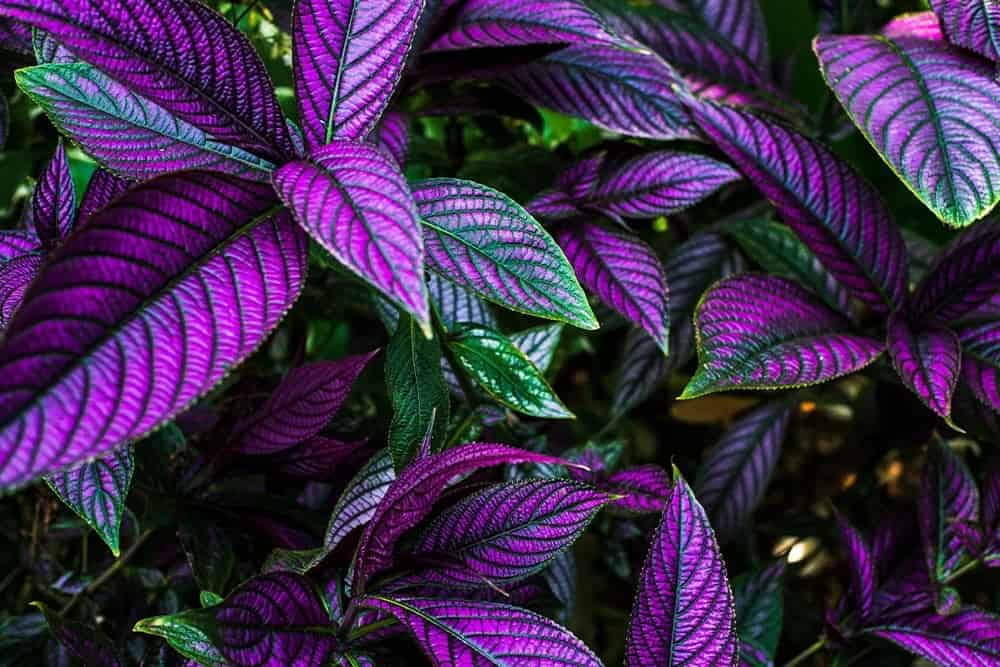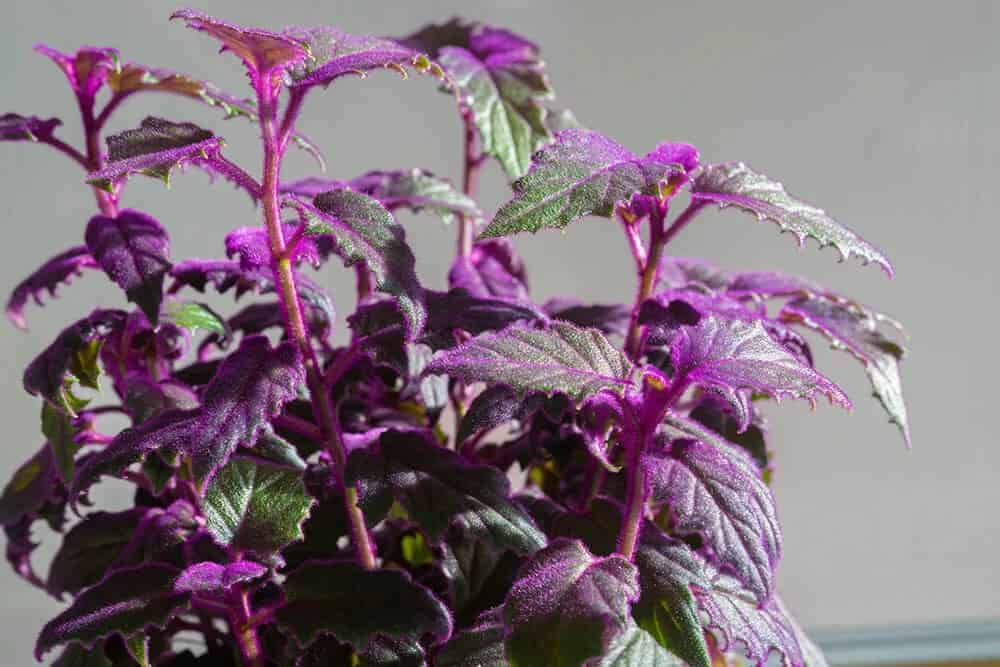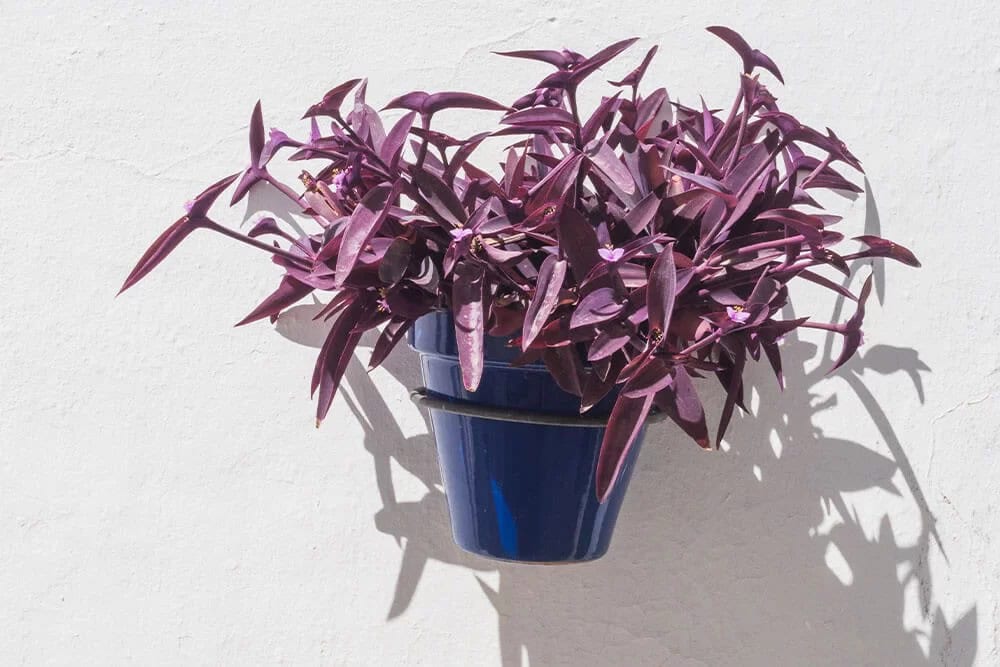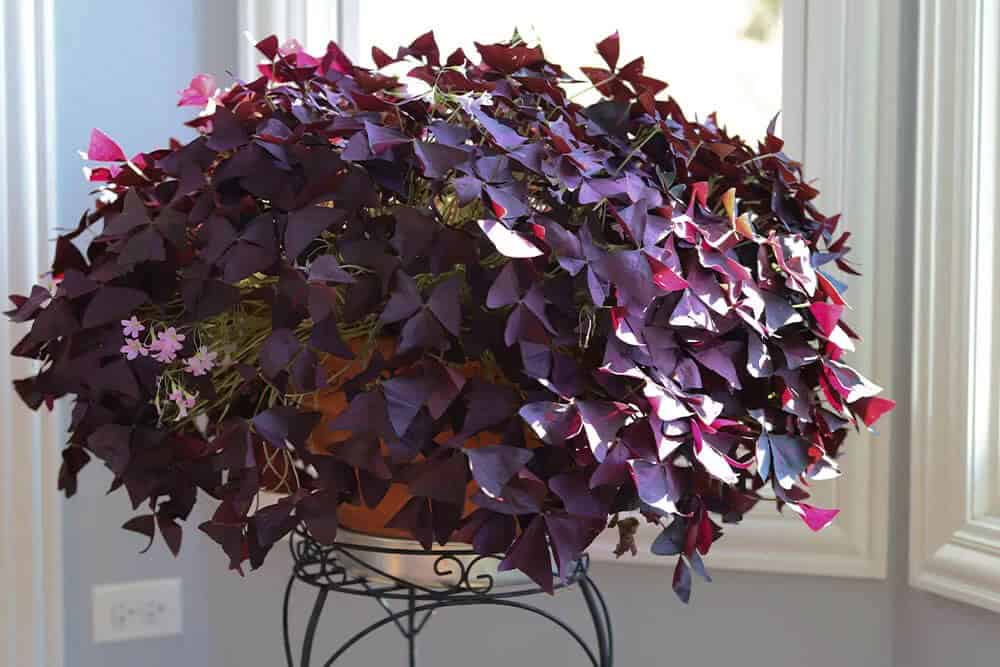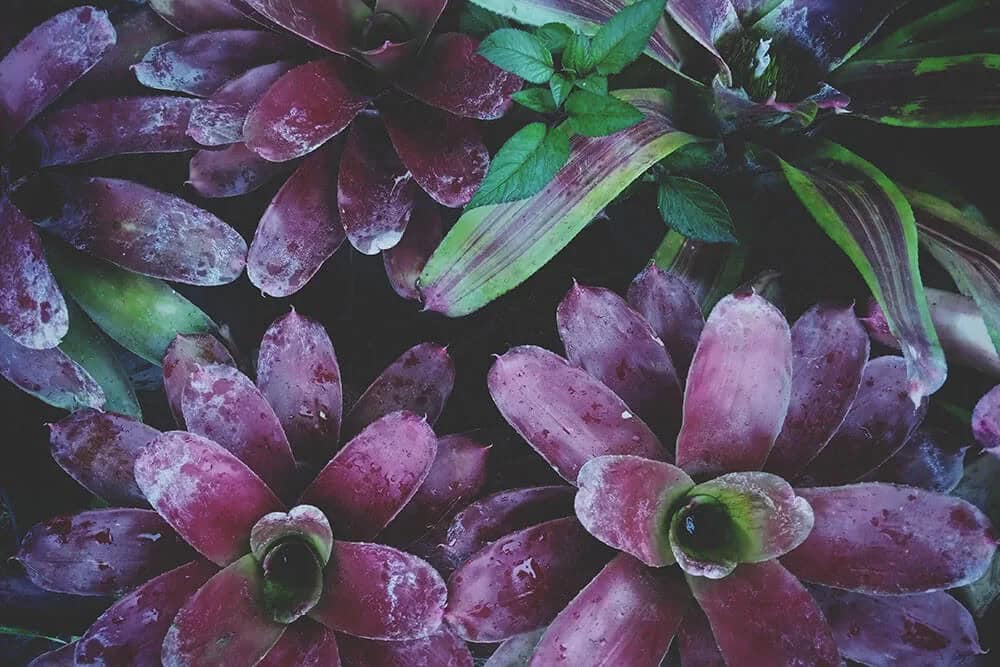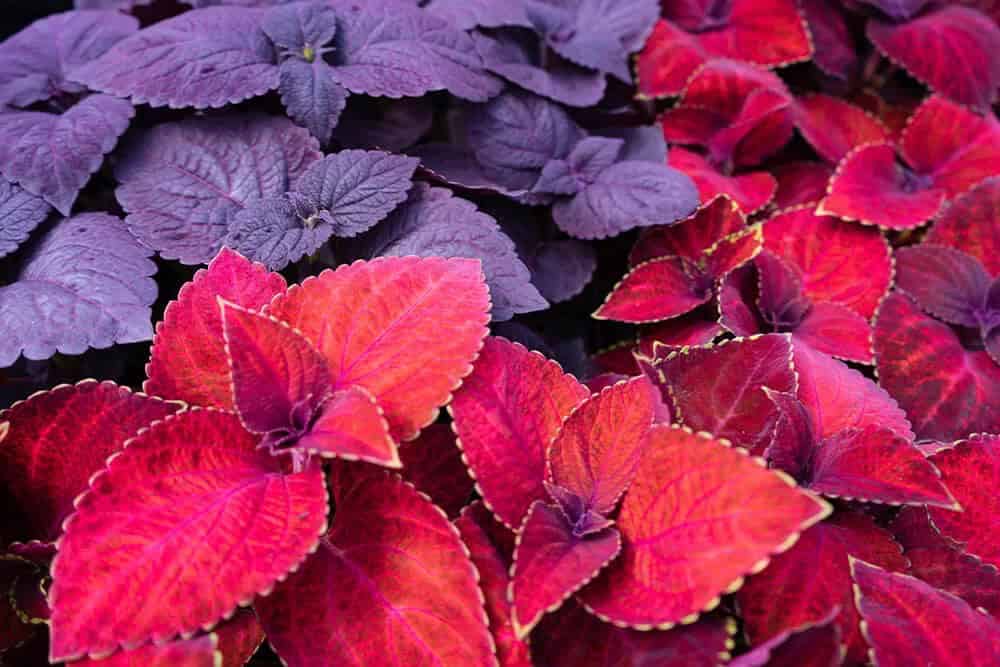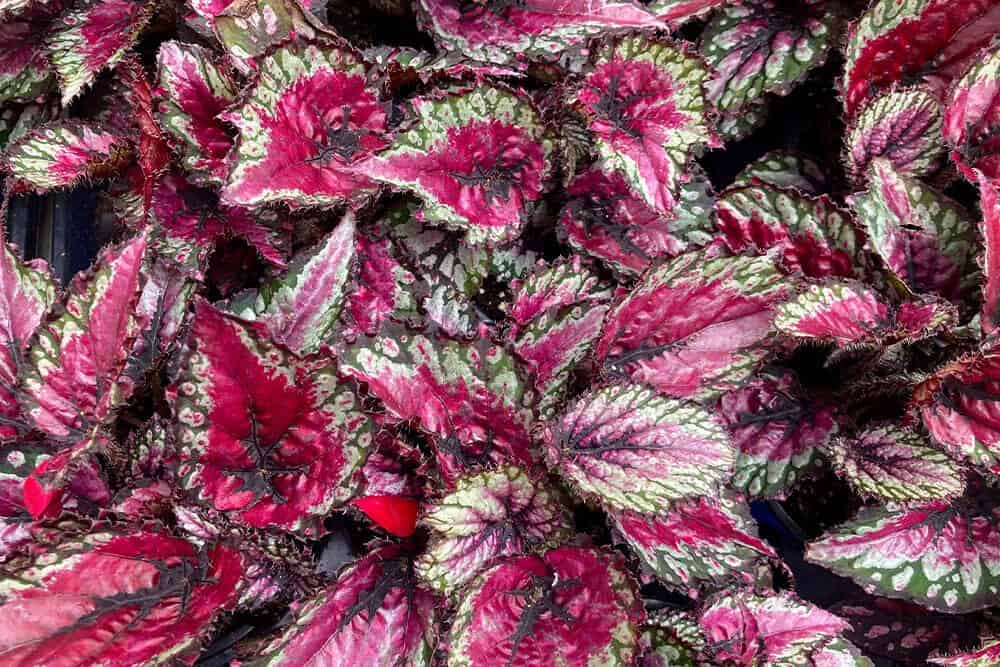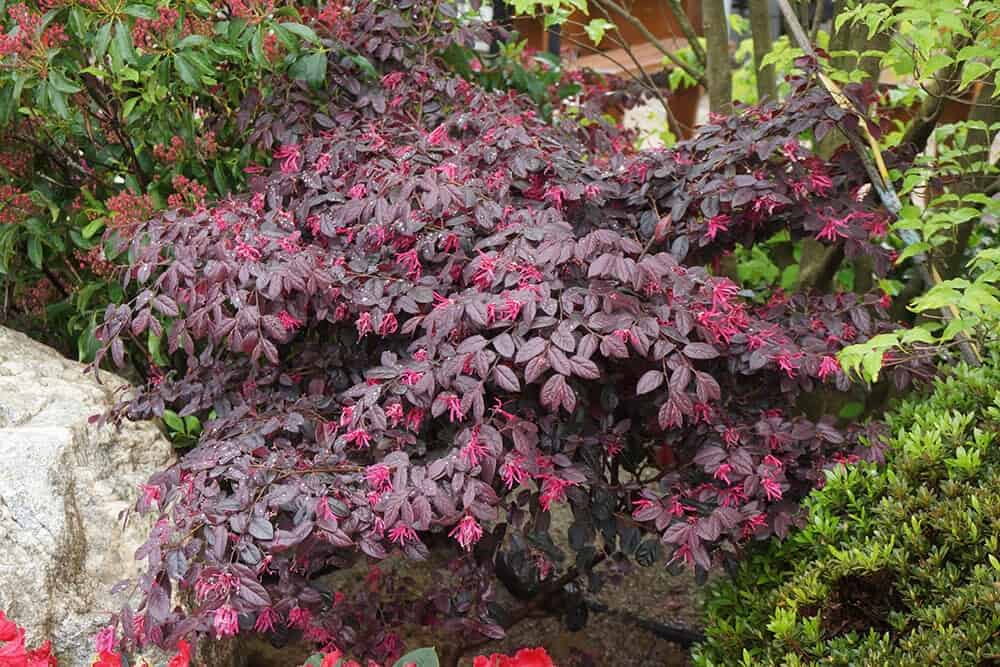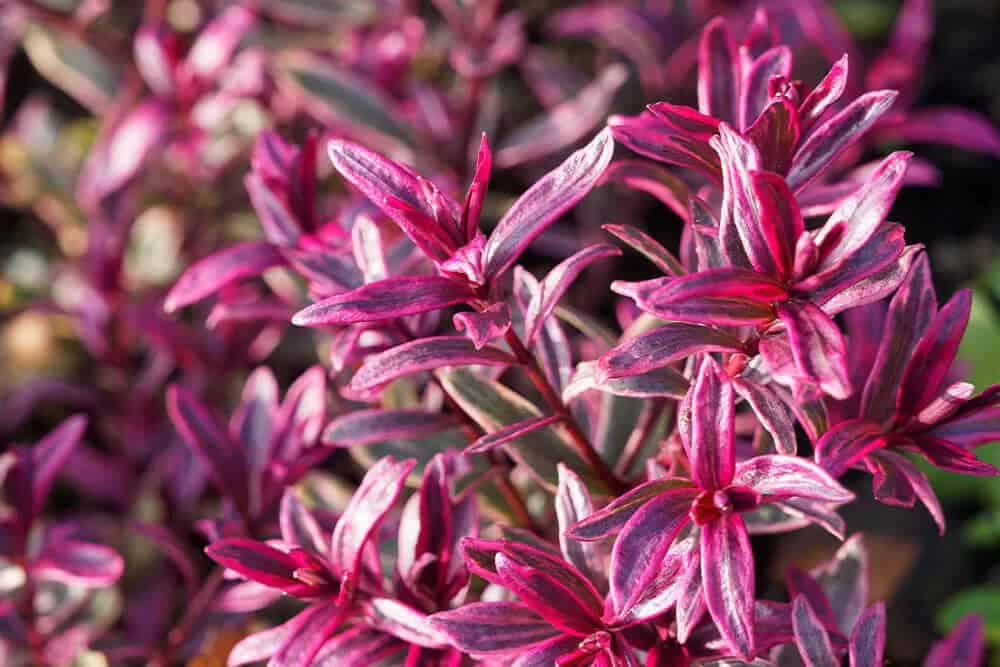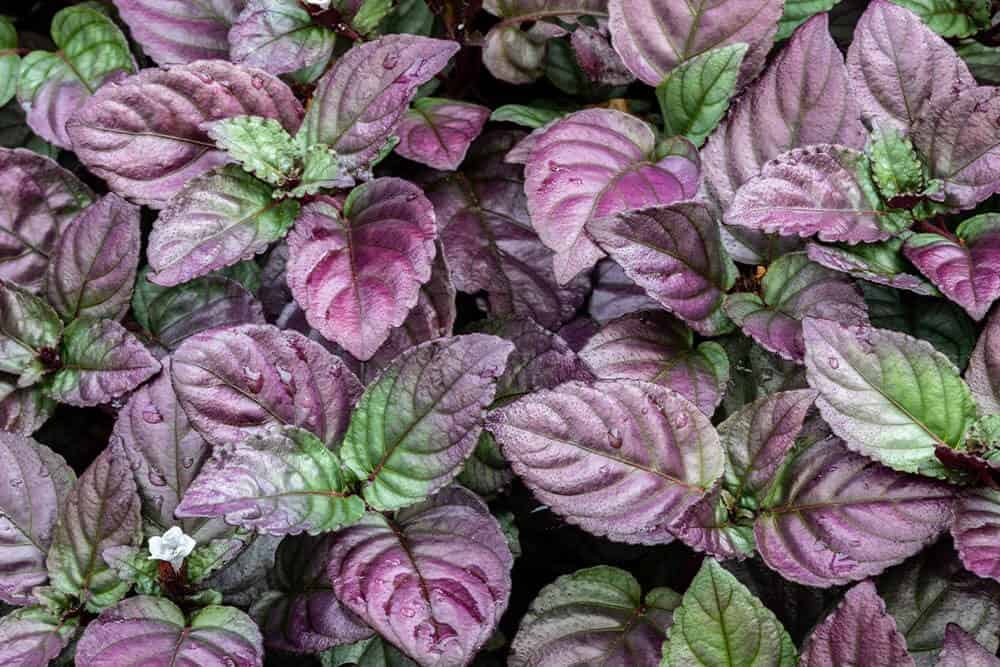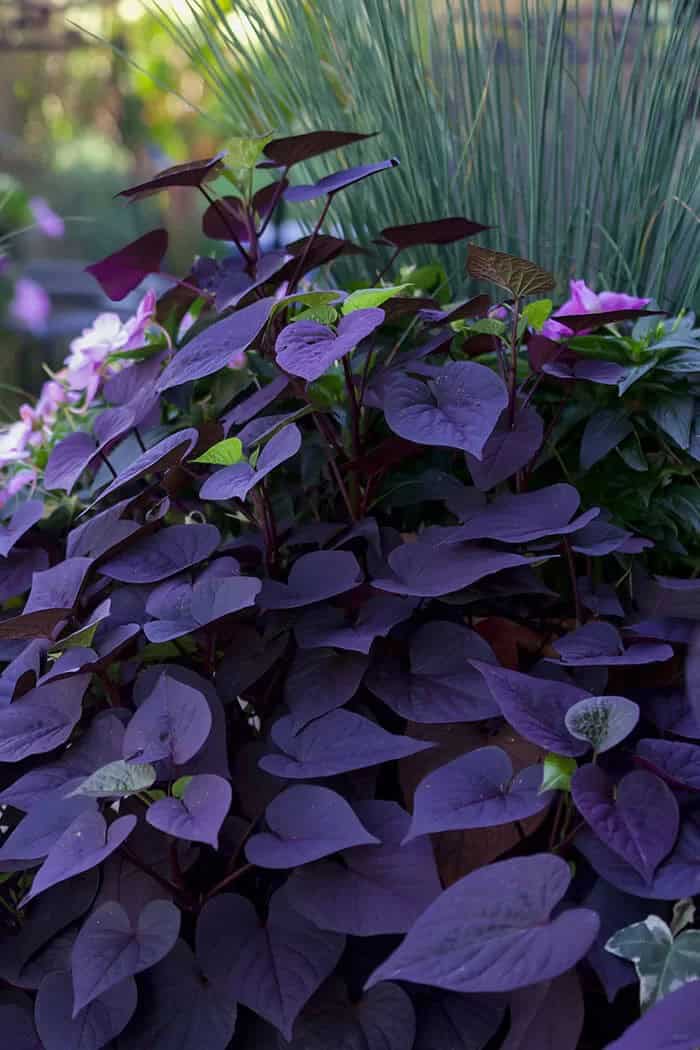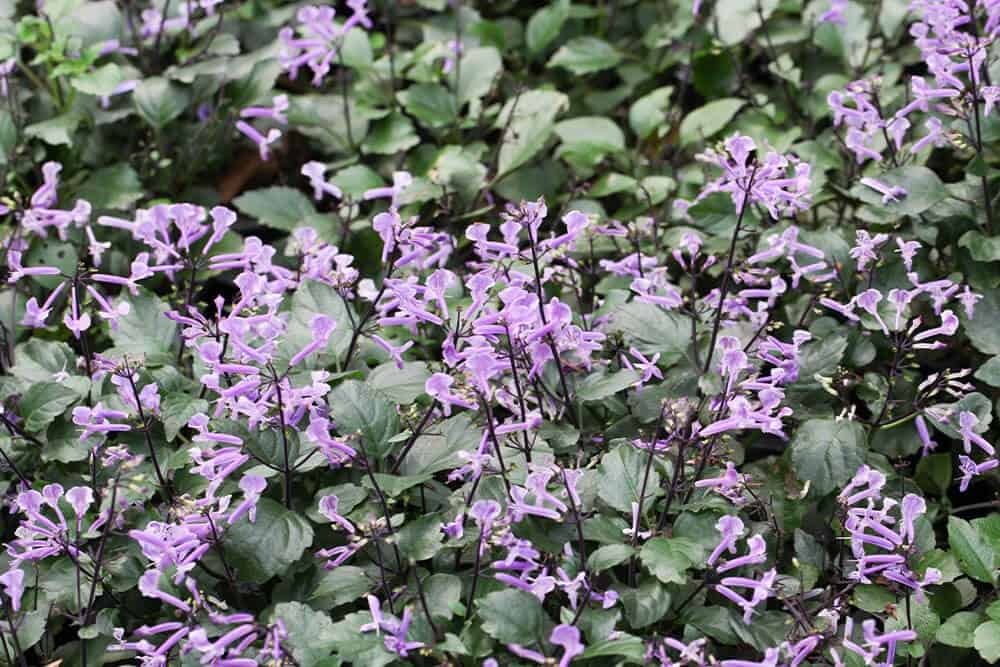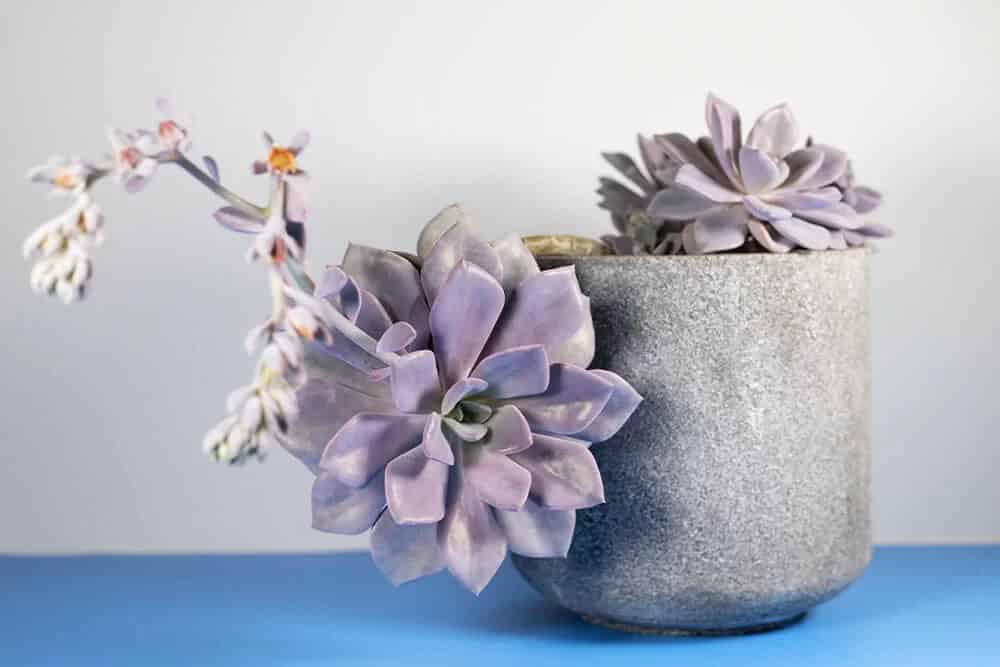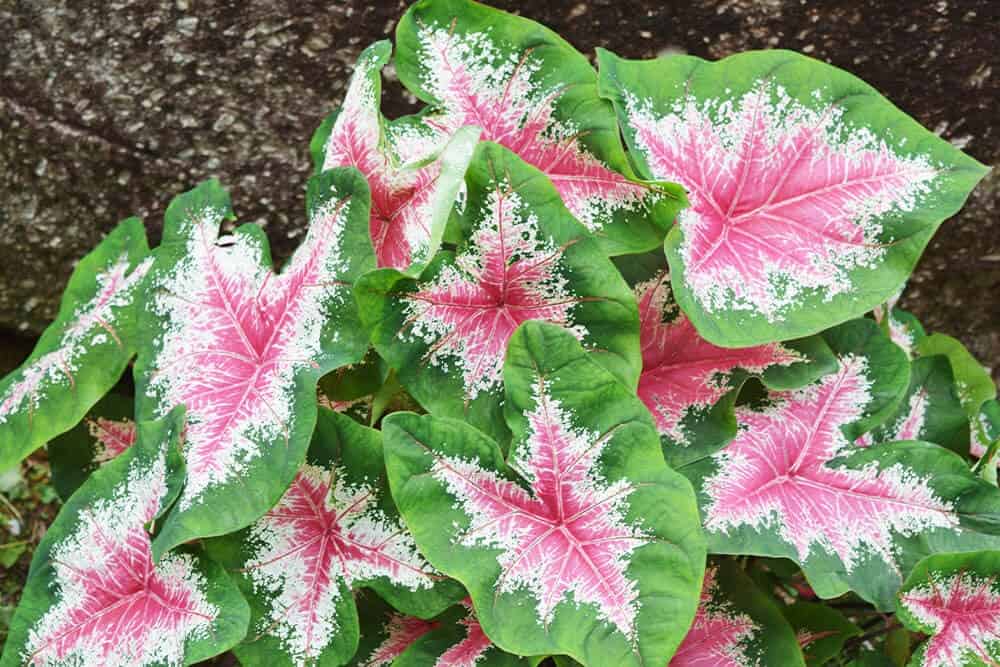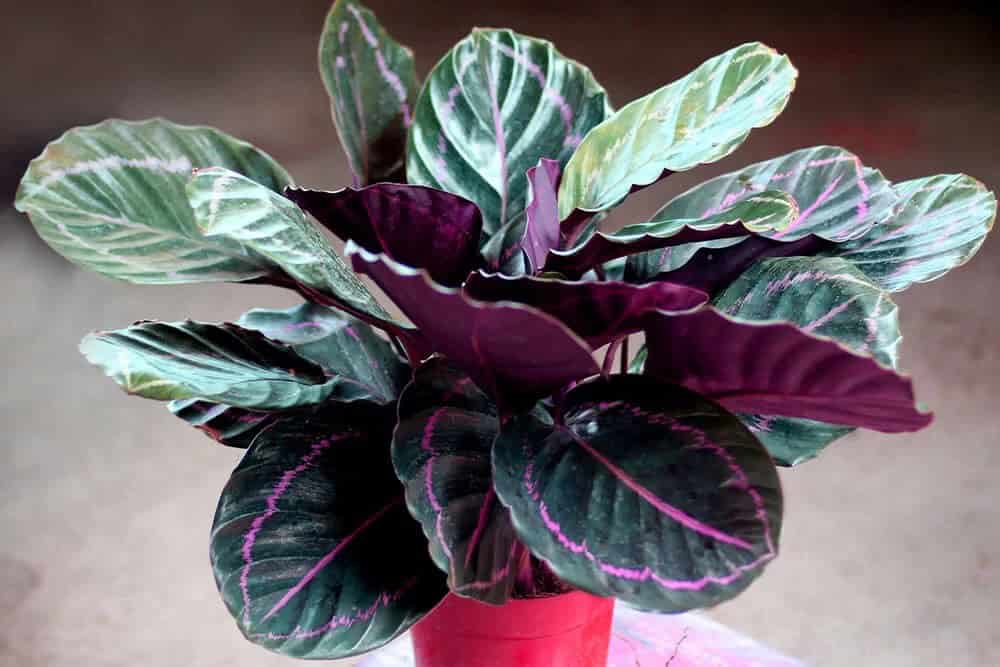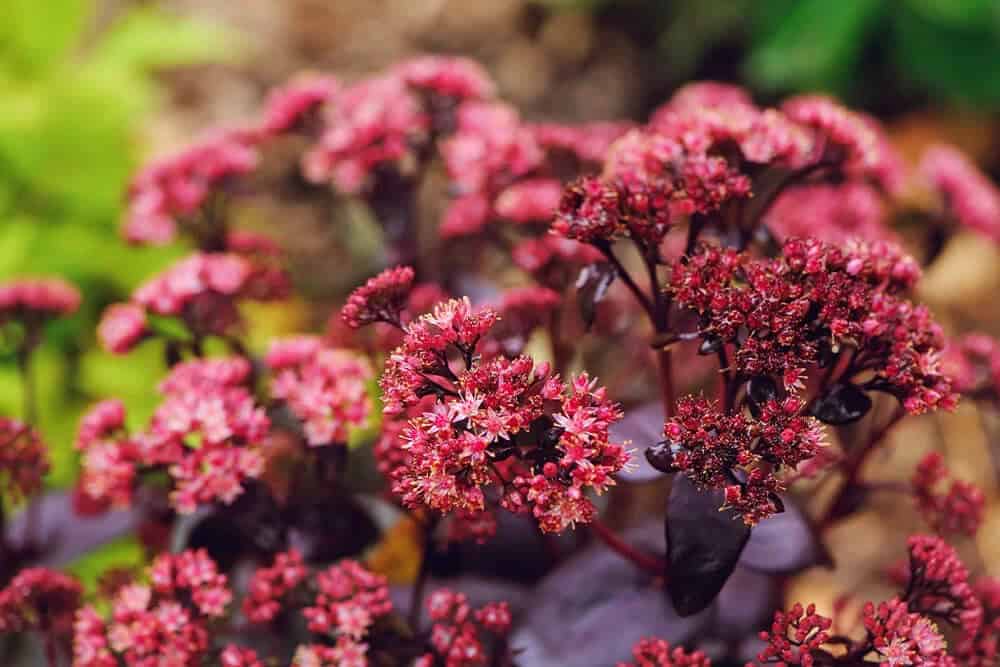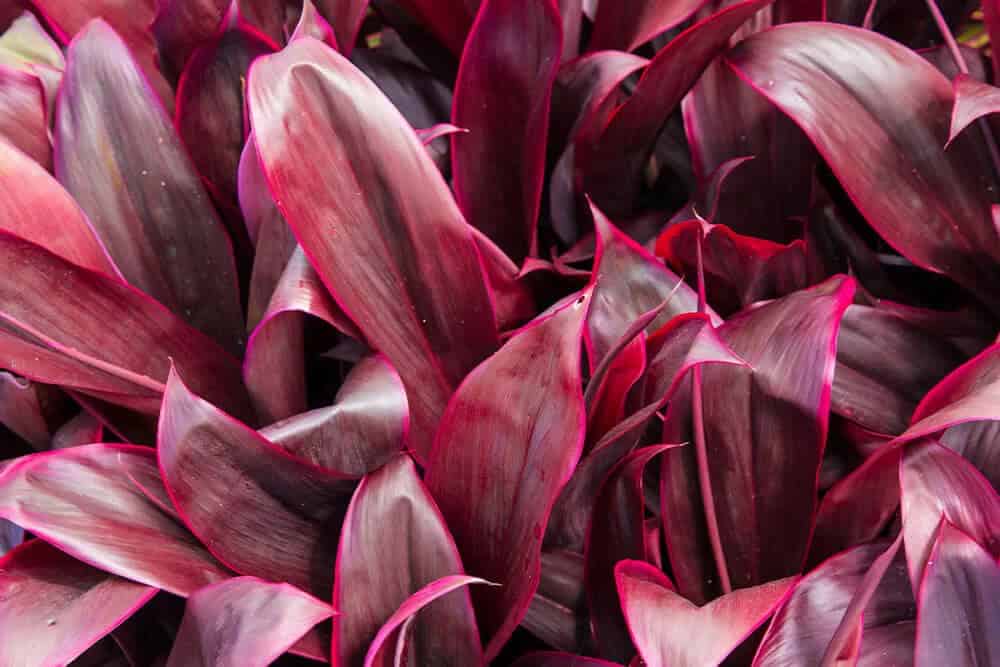Beyond the allure of big blooms, showy ornamentals like peonies and chrysanthemums often steal the spotlight. Yet, there’s a world of beauty waiting to be discovered in the realm of striking foliage. Unlike fleeting flowers, leaves can remain vibrant for months on end, offering an ever-changing kaleidoscope of colors and patterns. The most captivating aspect? Leaves offer a level of intricacy and complexity that even the showiest flowers can’t match.
One of the most breathtaking examples is the deep purple hue produced by anthocyanins in tropical plants. These pigments not only protect against damaging ultraviolet light but also deter herbivory, resulting in a range of colors from magenta to maroon. While many of these species are tender and require controlled environments, they make ideal container or houseplants. Explore the following 19 purple-leaved houseplants that will transport you to a world of color and beauty.
From lush vines to compact succulents, each plant boasts a level of vibrancy in a single leaf that rivals entire seasons’ worth of blooms. In this selection, you’ll not only discover these stunning plants but also learn how to keep them thriving, maximize their color, and uncover the secrets behind why so many plants sport purple leaves. If purple is your passion, these houseplants are sure to captivate!
Key Takeaways
The vibrant hues of purple foliage are largely attributed to anthocyanins, a family of molecules that play multiple roles in plant biology. In leaves, their primary function is to safeguard the foliage from two primary threats: excessive light and heat, as well as herbivory (being eaten). Since they are complementary to green leaves, they effectively reflect a significant amount of red light, which plants utilize for photosynthesis.
This can be particularly beneficial for plants growing in exposed locations where intense sunlight might damage chloroplasts. Additionally, anthocyanins ‘camouflage’ the plant from herbivores attracted to green coloration and can also be distasteful. As one would expect, most purple-leafed plants will exhibit their most striking colors when grown in full sun. This is indeed the case for many of the plants listed, but a few may require more protection from direct sunlight.
These plants tend to thrive in bright, indirect or filtered light, or with some afternoon shade. When growing houseplants under artificial lighting, it’s essential to consider the wavelength of light emitted by your lamps. High-energy wavelengths like ultraviolet and blue light stimulate anthocyanin production more efficiently than lower-energy wavelengths like red or green light. LEDs tend to produce a higher proportion of high-wavelength light.
Temperature also plays a crucial role in anthocyanin production, with many plants producing more of these molecules at cooler temperatures. The ideal combination for most purple-leafed plants is low temperature and high light. While purple coloring can occasionally indicate pathology, particularly in plants that don’t normally display this trait, it’s often caused by a phosphorus deficiency. This is especially common in tomato plants, and can be easily resolved with fertilizer application.
However, if your in-ground plants consistently develop purple spots, you may need to amend the soil.
19 Purple Leaf Indoor Plants for a Touch of Glamour
Persian Shield (Strobilanthes dyeriana)
Persian shield has been a beloved ornamental for centuries, yet its timeless allure endures. Perhaps it’s the striking contrast between the deep mauve and lilac hues of its foliage, accentuated by dark green veins, that gives this plant an otherworldly beauty. This enchanting appearance is not limited to the botanical realm; Persian shield’s nocturnal quality evokes a sense of mystery and romance.
While Persian shields thrive in zones 10 and 11 when grown outdoors, they’re equally well-suited for container life in most climates. With minimal maintenance requirements – just a couple of hours of direct sunlight and consistently moist soil – this plant is perfect for busy gardeners or those new to the world of horticulture. If your Persian shield does get too large, simply pinch back any wayward stems; indoors, these plants typically don’t grow too big.
Velvet Plant (Gynura aurantiaca)
The velvet plant’s unique appearance is not due to its leaves, but rather the fine purple hairs that cover its green (or variegated green and white) foliage. When grown in bright, filtered light, this feature becomes even more pronounced, giving the plant a striking two-toned look. This low-maintenance plant thrives when placed in the right conditions, though it can sometimes become leggy.
To encourage a more compact growth habit, a simple spray of a growth regulator like Florel is effective, with the added benefit of suppressing flowering – a good thing, as the flowers have an unpleasant odor. Fortunately, indoor plants rarely bloom anyway, making direct sunlight unnecessary and even beneficial to keep the plant’s growth in check.
Purple Heart (Tradescantia pallida ‘Purpurea’)
Purple heart, a resilient and visually appealing groundcover, thrives in well-drained soil and full sun. Its deep purple foliage adds a pop of color to outdoor borders and containers alike, making it an excellent choice for landscaping. When grown indoors, this lovely plant cascades beautifully over the edges of its pot, creating a stunning display. As an added bonus, purple heart produces delicate pink flowers in the summer that harmonize perfectly with its foliage.
However, it’s worth noting that plants grown in shade tend to have less vibrant, more muted green foliage rather than their signature deep purple hue. This low-maintenance plant is perfect for busy gardeners, requiring minimal care and attention. If your purple heart starts to outgrow its container, you can easily propagate new plants by clipping and replanting the stems, making it a great option for those looking to share or multiply their favorite plants.
Purple Basil (Ocimum basilicum var. purpurascens)
While many people think of basil solely as an herb for cooking, the deep purple leaves of purple basil are so stunningly beautiful that you might be tempted to leave them untouched. But don’t worry, you can still enjoy their unique flavor – a complex blend of cinnamon and anise notes – by using them in your culinary creations. In fact, purple basil is the same species as regular garden basil, with several varieties featuring striking purple leaves.
The most popular are Osmin purple, which is the original variety, and ‘Purple ruffles’, characterized by its ruffled and serrated foliage.
One of the many advantages of growing your own herbs is that they’re incredibly easy to care for. Purple basil is no exception – simply place it in a sunny window and water sparingly, and you’ll be rewarded with plants that not only look stunning but also taste fantastic.
False Shamrock (Oxalis triangularis)
Oxalis, commonly known as ‘wood sorrels,’ comprises a genus of flowering plants characterized by distinctive clover-like leaves and delicate five-petaled flowers. While many species are popular among gardeners, none capture attention like that of false shamrock. This plant boasts giant, purple leaves that fold up at night when disturbed, and its white-to-purple flowers, which bloom in direct sunlight, provide a whimsical contrast to the massive foliage.
In regions south of zone 7, false shamrock thrives as an outdoor perennial, but it also adapts well to container cultivation. A spot with east-facing orientation and some direct morning sunlight is ideal for this plant, which is relatively hardy and drought-tolerant. However, it may enter a dormant phase if exposed to extreme heat or dryness. Rest assured that once soil conditions and light are restored to optimal levels, the plant will regrow from its roots.
Neoregelia, Air Plant (Neoregelia ‘Purple Passion’)
Neoregelia’s unique characteristic as an epiphyte allows it to thrive on other plants or rocks rather than soil. This ‘air plant’ obtains its nutrients from the air, rainwater, and occasional top-dressing of clean water. The ‘Purple Passion’ variety stands out with its vibrant purple and green leaves featuring a striking purple center. Most neoregelias boast yucca-like leaves that turn red or purple at the base, but this exceptional variant displays a uniform hue throughout.
As epiphytes, neoregelia prefers bright indirect light and a soil-free environment. A suitable potting mix is less critical since it doesn’t derive nutrients from the soil. The key to success lies in avoiding overwatering – in fact, no watering is required at all! In their natural habitat, these plants collect rainwater in the cup-like center, making regular top-ups with clean water sufficient. Rainwater is ideal for this purpose, ensuring optimal health and preventing bacterial growth.
Coleus (Coleus spp.)
Coleus is often grown as an annual outside due to its rapid growth rate and frost sensitivity. However, with a little creativity, you can coax these vibrant plants into thriving as perennials indoors. By growing coleus in containers, you can enjoy their unique and eye-catching foliage year-round. This stunning plant has been prized for centuries for its kaleidoscope of colors, including shades of red, pink, and purple.
From the striking monochrome varieties like ‘Amethyst’ and ‘Black Beauty’ to the high-contrast greens and violets of ‘Felix’ and ‘Giant Fantasy’, coleus offers endless options for adding a pop of color to your indoor space. Like many plants, coleus thrives in bright, indirect or filtered light and is relatively low maintenance, making it an ideal choice for busy homeowners.
Rex Begonia (Begonia rex-cultorum)
Begonias are renowned for their striking foliage hues that belie their effortless growth requirements. This stunning display of colors has earned them widespread popularity as houseplants, with hundreds of unique varieties available to suit every taste. Among these, ‘Purple Spec’ and ‘Purple Rain’ stand out for their breathtaking purple tones, but there’s much more to explore! Begonias thrive in warm, humid environments, making them perfect for indoor cultivation.
To ensure the soil stays consistently moist – without becoming waterlogged – place the plants in a tray with small pebbles and water. While bright, indirect light brings out the best colors, direct sunlight can scorch their leaves. If your begonia is positioned near a south- or west-facing window, consider draping a sheer curtain over it to filter the intense afternoon sun.
Fringe flower (Loropetalum)
Fringe flower, an evergreen shrub with plum and maroon foliage that’s often referred to as ‘ever-purple’, is a stunning addition to any room. While it thrives in outdoor conditions, its light requirements mean it’s not typically grown indoors – unless you have a large south-facing window. When grown outside, fringe flowers can be kept in containers and brought inside when temperatures start to drop.
The majority of fringe flower varieties boast reddish-to-purple leaves, with a few standouts like ‘Purple Diamond’, which pairs deep purple foliage with vibrant pink blooms, and ‘Purple Pixie’, a dwarf version ideal for smaller spaces. As a full-sun plant, fringe flowers require more frequent watering during the growing season – up to twice a week in spring and summer – but adjust to less frequent watering (weekly or bi-weekly) once winter arrives.
Woodland Spurge (Euphorbia amygdaloides var. purpurea)
Woodland spurge is an enigmatic plant that defies conventional expectations. Its leaves are the true showstoppers, boasting a vibrant array of colors that more than make up for the unassuming yellow-green hue of its flowers. The disparity between its striking foliage and ordinary blooms can be jarring at first, but rest assured it’s a natural part of this plant’s charm. In fact, some varieties like purpurea feature deep-maroon succulent leaves that are unlike any other ornamental out there.
Woodland spurge is also one of the few ornamentals that can thrive in dry shade, making it an ideal choice for planting under oak trees where many other plants might struggle to survive. But what’s truly remarkable about this plant is its ability to excel as a low-maintenance houseplant too. Simply pot it in a cactus mix, place it in a spot with some morning sun, and enjoy the year-round display of textured and colored foliage that will add a unique touch to any room.
Waffle Plant (Strobilanthes alternata)
The waffle plant, a member of the Strobilanthes genus that also includes the Persian shield, is one of over 300 species cultivated as houseplants. While its rich lilac foliage with dark green veins bears some resemblance to the Persian shield’s leaves, it’s actually more sensitive to cold temperatures and cannot be grown outdoors in most parts of the US. This makes it an excellent choice for indoor cultivation.
To bring out the deep purple color of the foliage, provide bright indirect light – direct sunlight can cause scorching. Interestingly, not all waffle plants exhibit the characteristic crinkled leaves; the ‘Exotica’ variety is particularly notable for its pronounced waffle-like texture and vibrant color. To encourage a bushy, compact shape, simply pinch off the stems just above where new leaves emerge, directing the plant’s energy towards leaf growth instead.
Purple Sweet Potato (Ipomoea batatas ‘Sweet Caroline Sweetheart Purple’)
While sweet potato vines may not be the most glamorous houseplants, they offer a unique combination of striking foliage and hardy adaptability. Belonging to the same genus as morning glories, these ornamental plants boast leaves that transform from heart-shaped younglings to deeply lobed, dragonfly-like or intricately patterned adult leaves.
Their ability to thrive in heat and humidity makes them an excellent groundcover option, but they also flourish in containers, spilling forth like a verdant fountain. A range of varieties showcase rich hues of purple and maroon, such as ‘Sweet Caroline Red’ and ‘Sidekick Black’, whose deep coloration is almost black. However, sweet potatoes are susceptible to root rot due to their large tubers, so it’s essential to ensure they’re planted in well-draining soil.
And, of course, don’t forget that you can indulge in those very same tubers – simply pair them with some fragrant purple basil for a culinary treat!
Mona Lavender (Plectranthus ‘Mona Lavender’)
Mona lavender’s understated beauty is often overlooked, but take a closer look at its evergreen foliage and delicate purple flowers, and you’ll discover a treasure trove of surprises. The glossy leaves may appear lush green from above, but flip them over, and you’ll find a stunning purple hue hiding beneath the surface – a result of fine, velvety hairs reminiscent of Persian shields. This intriguing trait is akin to having ‘business on top, party underneath’!
The vibrant lavender flowers perfectly complement the verdant foliage while showcasing the leaves’ secret purple color. Despite its common name, Mona lavender isn’t closely related to lavender; instead, it belongs to the same family (Lamiaceae) as other mint-like plants.
This shade-tolerant houseplant thrives in indoor conditions and boasts a unique blooming schedule that makes it ideal for year-round gardening: it begins flowering in the fall and continues right through spring, providing a much-needed splash of color even during the winter months.
Boat Lily (Tradescantia spathacea)
Boat lily, also known as Moses-in-the-cradle, bears a closer resemblance to purple heart than its name suggests. The striking green-and-purple variegated foliage is reminiscent of this plant. However, boat lily boasts a neater appearance, with an upright and compact rosette of large sword-shaped leaves that are less sprawling than those of purple heart.
Its tidy nature is likely due to its ability to thrive in a wide range of soil conditions and light environments, making it an ideal choice for even the most novice gardeners. Additionally, boat lily exhibits remarkable resistance to pests and disease, ensuring your plant remains healthy and thriving. If you prefer a fuller appearance, consider planting it in a hanging planter where its stems can dangle freely.
On the other hand, if a more contained look is desired, simply snip any emerging runners from the central rosette, as they are easily propagated.
(Echeveria ‘Purple Pearl’)
Caladium, Angel’s Wings (Caladium bicolor ‘Va Va Violet’)
The caladium plant is a stunning addition to any garden or indoor space, boasting an array of mottled shades on its magnificent foliage. From the subtle tones of green, red, pink, and white to the striking polka-dotted patterns, each variety is a unique masterpiece. One standout cultivar is ‘Va Va Violet’, featuring enormous leaves with vibrant pink and purple hues bordered by dark green, creating an breathtaking display.
These ornamentals are grown from bulbs, similar to lilies and irises, and belong to the same family as calla lilies. Caladiums thrive in shaded gardens and indoor environments, where they can be treated to bright morning light with afternoon shade for optimal foliage coloration. Consistent watering ensures their leaves remain tall and healthy. Whether planted directly into the ground or potted, caladiums are truly ‘angelic’ ornamentals that are sure to captivate and inspire.
Calathea (Goeppertia roseopicta ‘Dottie’)
If subtle yet striking foliage is your preference, calathea ‘Dottie’ might just fit the bill. This unique variety boasts large, dark green leaves with a showstopping twist: vibrant pink or purple stripes running down the middle of each leaf. The resulting effect is even more captivating than an all-purple plant, almost surreal in its beauty.
While growing calatheas can present a challenge, particularly when it comes to maintaining optimal humidity levels (daily misting is crucial), the payoff is well worth the effort. With proper placement and some experimentation with watering, you’ll find that ‘Dottie’ becomes a very low-maintenance addition to your plant collection.
Stonecrop (Sedum ‘Purple Emperor’)
Stonecrops are part of an incredibly diverse genus that boasts over 400 species of succulent plants, predominantly found in North and South America. These hardy, creeping plants have earned the admiration of many gardeners for their durability and visual appeal. Some varieties also thrive as indoor plants, offering a unique combination of beauty and practicality.
The ‘Purple Emperor’ hybrid stonecrop is one such variety that stands out for its remarkable height, reaching up to 12 inches or more, and spreading slowly from a central clump. Its striking, dusky purple foliage is accompanied by large clusters of vibrant pink flowers that last for several months during the late summer season. In terms of lighting conditions, ‘Purple Emperor’ and stonecrops in general do exceptionally well in bright, filtered light.
Direct sunlight is also acceptable; however, excessive shade can lead to etiolation, resulting in long, floppy stems as the plant attempts to reach the sunlight. On the other hand, more sun exposure will not only enhance flower production but also result in richer foliage. Like many ornamental succulents, this hybrid stonecrop demonstrates remarkable tolerance for dry and infertile soil conditions. In fact, overly fertile soil can lead to similar issues as excessive shade.
As a result, it would make an excellent addition to a miniature rock garden or other low-maintenance settings.
Ti Plant (Cordyline fruticosa)
While ti plants are often associated with traditional Hawaiian ‘grass’ skirts, they’re also a stunning and low-maintenance option for indoor spaces. The leaves of the ‘Soledad Purple’ and ‘Purple Prince’ cultivars display striking magenta hues that gradually transition to purple and green as they mature. To showcase these colors at their best, bright filtered light is ideal. Ti plants are often mistaken for dracaena, but this isn’t a major concern given their similar care requirements.
The key to keeping your ti plant happy is consistent soil humidity, which can be achieved by placing the pot on a saucer filled with rocks and water or waiting until the top layer of soil dries out before watering again. It’s worth noting that this plant is sensitive to fluoride, so if you’re using tap water with added fluoride, you may want to consider switching to distilled water instead.
19 Gorgeous Purple Leaf Houseplants Featuring Stunning Foliage
Among the lush greenery of the plant kingdom, one peculiar characteristic stands out – the mesmerizing allure of purple foliage. While it may seem like an unusual trait, many houseplants flaunt vibrant violet leaves that demand attention. Take these plants, for instance, which boast striking hues reminiscent of a mystical realm.
What’s more fascinating is that their coloration serves as a subtle cue to their care requirements: the deeper the purple, the brighter and more indirect the light they crave. By providing just the right amount of illumination and tender loving care, these remarkable plants will continue to captivate for years to come.
Frequently Asked Questions About Purple Leaf Indoor Plants
What houseplants have purple leaves?
While not an exhaustive compilation, this list showcases some of the most well-known houseplants boasting stunning purple foliage. Among these, the Persian shield, Velvet plant, and Purple heart stand out for their particularly vibrant displays.
What indoor plant is purple?
Many of the plants mentioned earlier can thrive indoors, and a striking commonality among them is their rich purple hue. In fact, most purple plants that can tolerate some shade can be easily cultivated indoors. Similarly, even full-sun loving plants can be grown inside if you have a spot with sufficient sunlight.
If not, you can always relocate them outside during the spring and summer months when they require more intense light, then bring them back in during fall as their photosynthetic activity slows down and reduced light becomes sufficient.
What causes purple leaves on plants?
The striking phenomenon of purple leaves is attributed to the buildup of anthocyanins, specialized pigments that safeguard the leaves from harmful solar radiation and grazing by herbivores. Interestingly, this adaptation is often seen in plants thriving in high-light environments, where intense sunlight drives the production of these protective compounds.
However, the appearance of purple spots on leaves can also signal a phosphorus deficiency, highlighting the complex interplay between environmental conditions, nutrient availability, and the evolution of plant defense strategies.
What deficiency causes purple leaves?
Phosphorus deficiencies in certain plants can manifest as purple spotting on the lower leaves, a distinct phenomenon from typical leaf coloring. Surprisingly, the underlying mechanisms involve similar chemical pathways: while signaling phosphorus scarcity and producing anthocyanins share structural similarities, this similarity leads to an overabundance of these compounds when phosphorus is scarce.
What nutrient turns plants purple?
The vibrant purple hues found in leaves and certain fruits like blackberries and blueberries are attributed to the presence of anthocyanins, potent antioxidants that offer numerous health benefits for humans as well. Interestingly, this same pigment can also serve as an indicator of nutritional deficiencies, specifically a lack of phosphorus.
While the underlying cause remains the same – the accumulation of anthocyanins – the reason behind this phenomenon is distinct: when plants experience phosphorus starvation, they produce excess anthocyanins, effectively ‘malfunctioning’ in response to their environmental stress.
